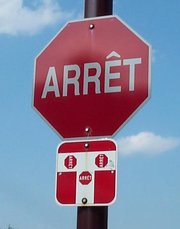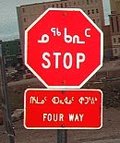Stop sign
|
|
Stop_sign.png
Old_uk_stop_sign.png
A stop sign is a traffic sign, usually erected at road junctions, that instructs drivers to make a brief and temporary, but complete, stop upon reaching it, and then to proceed only if the way ahead is clear.
Stop signs are not generally required at every intersection, but they are often used to control conflicting traffic movements at dangerous intersections which are not busy enough to justify the installation of either traffic lights or, especially in Europe, a roundabout. In the United States and Canada they are commonly used in residential areas, and near places where children play, as a general traffic calming measure. In these countries it is not uncommon for stop signs to be erected on all three or four intersecting roads.
The following remarks concerning the right-of-way rules at intersections with multiple stop signs apply to the United States and Canada.
Cross_traffic_does_not_stop.jpg
- Generally, the driver who stops first continues first.
- If two drivers stop simultaneously at stop signs at a single intersection, the rule is that the car on the right-hand side, or the most counterclockwise, has the right of way.
- Stop signs may be augmented with additional information such as a plate with the legend "4-way stop". This is important because a driver accustomed to negotiating four-way stops may be tempted to ignore "his own" stop sign, relying on what he assumes to be the requirement for vehicles approaching from other directions to stop. The consequences of thus jumping what is, in fact, a two-way stop can, quite obviously, be disastrous. The assumption has therefore to be, if there is only a plain stop sign, that cross traffic will not stop. "4-way stop" plates are provided on the fail-safe principle that if they are missing (through disrepair, vandalism, etc.) the "more dangerous" message is given.
Stop signs, usually based on the American design, are found all over the world, although in Europe they tend to be used far more sparingly than in North America, generally being restricted (on the principle that "familiarity breeds contempt") to situations where coming to a dead stop is absolutely essential because of poor visibility at the intersection concerned. In all countries, the driver must actually stop even if no vehicles or pedestrians are visible. However, some drivers practise the illegal manoeuvre known as a rolling or "California" stop: slowing down significantly but not stopping completely at the sign.
Yield signs ("Give way" signs in the UK, Australia, and New Zealand), on the other hand, require the driver only to slow and prepare to stop, but do not require an actual stop if the way ahead is clear.
| Contents |
History
Stop signs originated in Detroit, Michigan in 1915. The first had black letters on a white background and were somewhat smaller than the modern one. As they became more widespread, a committee supported by AASHO met in 1922 to standardize them, and it selected the octagonal shape that has been used in the US ever since.
The unique eight-sided shape of the sign allows drivers facing the back of the sign to identify that oncoming drivers have a stop sign and prevent confusion with other traffic signs.
In 1924, the sign changed to black on yellow, the predominant color until 1954. Another competing group, the NCSHS, simultaneously advocated an even smaller, red-on-yellow stop sign. All of these signs were typically mounted only two or three feet above the ground.
These two organizations conflicted but eventually combined into the Joint Committee on Uniform Traffic Control Devices, which in 1935 published the famous Manual on Uniform Traffic Control Devices for Streets and Highways (MUTCD) detailing the stop sign's appearance. The MUTCD stop sign was altered eight times between 1935 and 1971, mostly dealing with its reflectorization and its mounting height; the most drastic change came in 1954, when the sign gained its white-on-red color. Red is also the color for stop on traffic signals, unifying red as stop signal for drivers worldwide.
The mounting height reached its current level of seven feet in 1971. Although already widespread, use of the MUTCD stop sign passed into law in the United States in 1966. They were later adopted by the European Union as part of their effort to standardize road travel across member countries.
Stop signs worldwide
Reef_Road_Houses.jpg
Although English-speaking and European Union countries use the original word "STOP" on stop signs, most countries, and sometimes even smaller political districts, prefer to use a roughly equivalent word in their primary language instead; its appearance is otherwise the same of white text on a red octagon. The few known exceptions include Israel (which uses a solid white hand on a red octagon) and Japan (which uses the local word for Stop in white type on an inverted solid red triangle). Although the word used isn't universally standardized, some commonly seen examples are:
| Word | Language | Countries or regions where used |
| STOP | English | United States, United Kingdom, Canada, Australia, Hong Kong, European Union countries such as France, Germany and Spain and elsewhere |
| ARRÊT | French | Parts of Canada such as Quebec, New Brunswick and airports |
| ALTO | Spanish | Mexico and elsewhere |
| PARE | Spanish | Peru, Dominican Republic |
| قف | Arabic | Arab countries including Saudi Arabia |
| CTOΠ | Bulgarian | Bulgaria |
| CTOΠ | Serbian | Serbia |
| DUR | Turkish | Turkey |
| SETEN | Huron | In parts of Canada with Wyandot people |
| 停 (ting) | Chinese | China, Taiwan |
| PARE | Portuguese | Brazil |
JapaneseStopSign.gif
XB010_GiveWay_White_on_Red_Triangle.jpg
The Japanese Stop Sign resembles a Give Way or Yield sign, with more red color, so that it is more emphatic.
.
.
.
.
.
See also
External links
- History of the Stop Sign in America (http://signalfan.freeservers.com/road%20signs/stopsign.htm)
- Stop Signs from Around the World (http://www.geog.okstate.edu/users/lightfoot/stop/page/main.htm)de:Stoppschild



